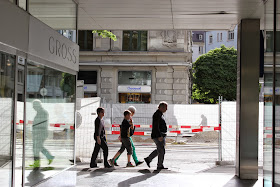Working for magazines from everywhere, I often never actually meet face-to-face the people I work with. I've been collaborating with Speech, the Russian journal that comes out two times a year, since it´s fourth issue, in 2009, thanks to a recommendation by Roland Halbe, but I never actually met Irina, its founding editor, or Jan Skuratowski, who worked beside her on every issue. Now as I am preparing my contribution to the first issue of Speech without her, I found this memorial written by another collaborator, Bernhard Schulz:
April 26, 2014 after a long illness passed away the chief editor of speech: Irina Shipova.
Getting ready for the latest issue of the Architectural journal speech:, released under the direction of Irina Shipova. This is the last issue of speech: to be delivered by Irina Chipova.
Altogether, there have now been 12 issues of speech: (you could call them ‘magazines’, but a better word would be ‘books’). The first was published in the middle of 2008; the new architecture journal quickly acquired a knowledgeable readership. Like all previous issues of speech: the current, 12th, issue is devoted to a single overarching theme.
Irina Chipova was born on October 26th 1968 in Moscow, where she went to school before going on to study at the History Faculty at Moscow State University. She submitted her diploma work in 1991. Meanwhile she had spent a year working at a children’s library and then another at the Shchusev Museum of Architecture. This was a time of preparation for the independent path that she was to follow subsequently. But first she worked for three years at the Central House of Architects in Moscow. Then, in 1997, she took an important step – deciding to leave Russia and move to Germany with her husband and son. She learnt German in Rostock before coming to Berlin in 1998, where her second son was born.
Working as an architecture critic, she started gathering around her the circle of fellow-thinkers who would subsequently prove so invaluable to her. In 2004 Irina started working for nps tchoban voss, where, as head of the PR department, she was instrumental in helping present and explain the firm’s architectural ideas and projects.
That same year, Irina took part in preparing Moscow-Berlin, an exhibition at the Shchusev Museum of Architecture in Moscow, and in 2007 she wrote ‘Moscow. Art and Design’, a handy guide to contemporary architecture and interior design in Moscow.
Irina’s work for other publications gradually gave way to the idea of creating a new journal dedicated to the state of contemporary architecture. The concept developed by Irina Chipova involved taking a single theme, a single building type, or a single architectural objective and subjecting it to comprehensive examination, beginning with an excursion into history and continuing with numerous examples of buildings from countries all over the world, accompanied by interviews with leading architects and comments from authoritative experts. Underlying the publication was a graphic concept in which text and images were to be of equal importance as sources of information, with equal weight being given to two languages, Russian and English.
The above concept was established at the very beginning of the journal’s life and it is perhaps the most surprising aspect of Irina Chipova’s work for speech: that the concept never required reworking. The diversity and balance of the various forms of contribution were a strong point of the new publication, as were the involvement of knowledgeable authors from different countries and the high quality of the photographs selected for inclusion.
While working on the journal, Irina was asked, as an experienced publisher, to produce the catalogue for the exhibition at the Russian Pavilion at the 12th Architecture Biennale in Venice in 2010. Irina coordinated this enormous volume of work as a ‘one-woman team’ in Berlin, with help from her colleagues in Moscow. She maintained numerous contacts with her circle of friends back home, and they responded with love and admiration for her kindness, talent, and professionalism.
From the end of the first decade of the 21st century, Irina found herself increasingly hampered by serious illness. Nevertheless, she continued working on speech:, without in any way compromising on the publication’s established standard of quality. Until her final days, she worked in bed on editing texts and captions for the issue which you have in your hands. She was unable to let a single important detail slip through her fingers. Her supreme professionalism, which never let the journal’s authors get away with vague phrasing, and her understanding of layout, which resulted in a substantive relationship between text and photographs, were unfailing. After a protracted illness, Irina Chipova died at home in Berlin on April 26th, 2014, a few days after submitting the final proofs for the 12th issue of speech:.
She was only 45 years old.
It was her unflagging enthusiasm for her work and her incredible resolve which enabled Irina to see the completion of this 12th issue of ‘her’ journal.
















